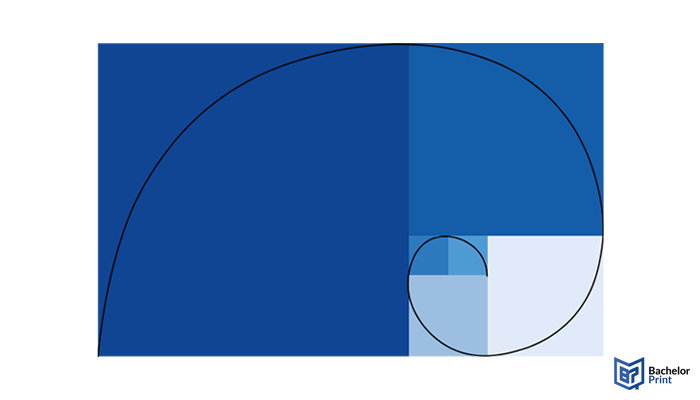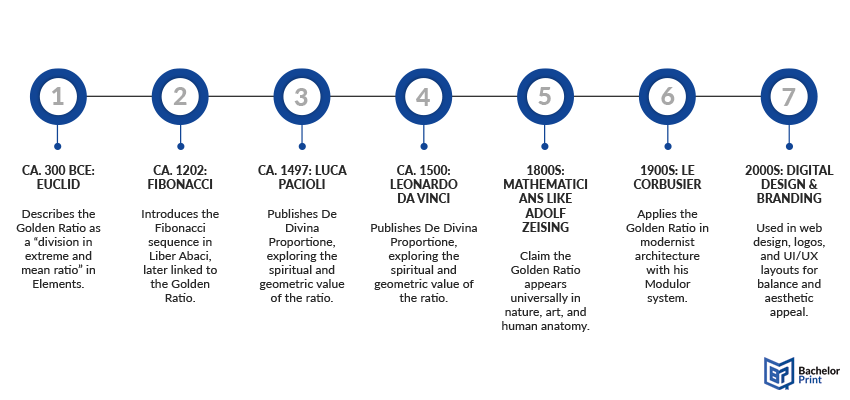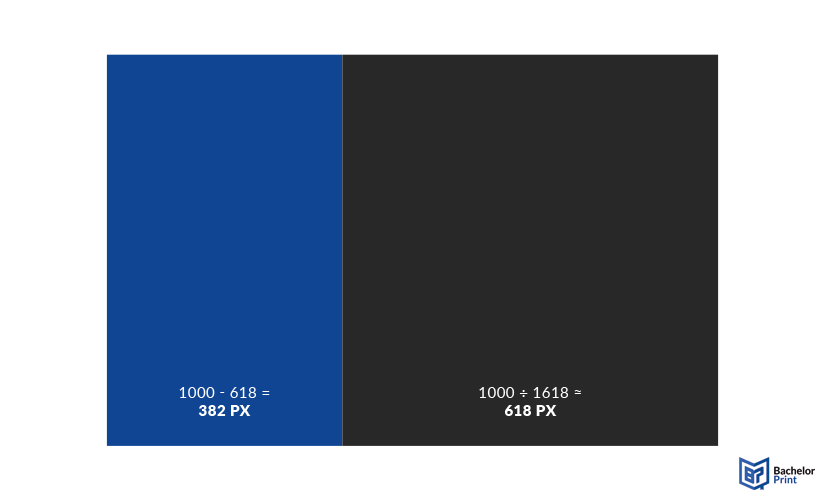
The Golden Ratio is a timeless principle that appears in nature, design, and architecture, and even in modern branding and publishing. Often referred to as the “divine proportion,” it’s known for creating layouts that feel balanced and visually appealing. In this guide, we’ll explore how the Golden Ratio connects to art, geometry, and even printing terms you might use every day.
Definition: Golden ratio
The Golden Ratio is a mathematical ratio commonly found in nature, art, and design. It describes a proportion where the ratio of two quantities is the same as the ratio of their sum to the larger of the two. Numerically, it’s approximately 1.618:1.
Mathematically, it is expressed as the Greek letter φ (phi), and its simplest form is:
φ = (1 + √5) / 2 ≈ 1.618
This ratio is closely connected to the Fibonacci sequence, a series of numbers (1, 1, 2, 3, 5, 8, 13, …), where each number is the sum of the two preceding ones. As the sequence progresses, the ratio between consecutive Fibonacci numbers approaches φ, which is considered a special form of mathematical elegance.
The Golden Ratio is also known as the divine proportion, the golden mean, or the golden section. It often appears in aesthetically pleasing compositions and is used as a guideline for achieving natural balance and layout flow, especially when applying a golden spiral overlay in design.

Your guide to print and production
- Information on print finishing & print processing
- Information on materials & optimal use of materials
- Information on printing processes & print production
Learn more!
History
The Golden Ratio’s history spans centuries, cultures, and disciplines.

Its earliest known description appears in the work of Euclid (circa 300 BCE), who referred to it as the division of a line in “extreme and mean ratio.” This idea later became known as the golden section and shaped classical architectural proportions in temples and monuments.

During the Middle Ages and Renaissance, the Golden Ratio gained fame through thinkers like Leonardo da Vinci and Luca Pacioli, who explored it as a special form of geometric and visual harmony. It was seen not only as a number but as a reciprocal form linking beauty and mathematics.

In the 13th century, Leonardo Fibonacci introduced the now-famous Fibonacci sequence in Liber Abaci, which forms a base sequence that approximates the Golden Ratio as it progresses. The connection between Fibonacci numbers and the golden proportion sequence helped build its mythos as a sequence of powers representing growth and natural order.

During the 19th century, the Golden Ratio began gaining popularity beyond classical mathematics. It was studied by scientists, artists, and architects who believed it to represent an ideal of natural beauty and structural harmony.

In the modern era, the Golden Ratio continues to influence graphic design, architecture, product development, and brand identity, proving its staying power across both academic and commercial applications.

Applications
From cathedrals and symphonies to websites and book covers, the Golden Ratio is used to create visually appealing compositions that feel “just right.” Below are some key areas where it’s applied.
The golden proportion has long been used in architecture to create spaces that feel naturally balanced and visually pleasing.
Today, architects apply golden ratio proportions to:
- Design golden rectangles within façades and floor plans
- Establish a visual hierarchy through consistent margin proportions
- Align windows, doors, and staircases based on architectural proportion
From temples to modern towers, it continues to inform structural design choices that result in buildings that “just feel right.”
Artists have used the golden proportion for centuries to create compositions that feel balanced, focused, and aesthetically satisfying.
In visual art, creators often apply:
- Reciprocal forms that mirror balance within a scene
- Golden rectangles to frame canvases and guide proportions
- A golden spiral overlay to direct the viewer’s eye toward focal points
- The Fibonacci sequence to structure recurring themes or spatial layout
- Layouts that follow beautiful page proportions for symmetry and rhythm
Whether used subtly or deliberately, it helps artists guide attention, structure compositions, and create works that feel intuitively “right.”
The Golden Ratio isn’t just in art and design, it also appears in the proportions of national flags, where balance and symbolism are key.
In flag design, it is used to:
- Position symbols and emblems based on precise internal angles
- Define edge lengths and height-to-width ratios using golden rectangles
- Create balanced layouts using diagonals and acute angles for dynamic composition
By using these ratios and angles, flags achieve a sense of unity and harmony that is both symbolic and visually effective, especially when viewed from afar or in motion.
The Golden Ratio is a favorite tool in graphic design, helping to create layouts, logos, and visuals that feel naturally balanced and harmonious.
Designers apply the golden proportion to:
- Build golden rectangles into layout grids for print and web
- Apply a golden spiral or logarithmic spiral to guide visual hierarchy
- Maintain margin proportions that add rhythm and harmony to designs
- Use a center rectangle derived from the golden ratios to anchor content areas
- Create beautiful page proportions by balancing text, imagery, and whitespace
Whether in posters, websites, or app interfaces, the golden mean helps designers deliver content that feels both natural and intentional.
The Golden Ratio appears in music through structure, timing, and phrasing, which offers a natural sense of flow and resolution.
Composers and producers apply it to:
- Shape progressions that reflect reciprocal form
- Organize sections as a base sequence of musical ideas
- Apply a special form of phrasing that helps guide emotional peaks
- Time key changes at around 61.8%, an approximate form of structural balance
- Layer melodies or themes as a sequence of powers, echoing mathematical symmetry
The result? Music that feels naturally structured. Even when the listener can’t explain why.
The Golden Ratio is found throughout the natural world where it appears in patterns, growth, structure, and form.
In nature, it:
- Repeats in reciprocal forms, such as tree branching and leaf placement
- Appears in shells and storms as logarithmic spirals, naturally optimized for space
- Represents one of nature’s most elegant approximate forms of balance and efficiency
- Reflects growth following a base sequence, often found in leaves, petals, and shell patterns
Its presence in organic forms continues to influence architects, artists, and scientists seeking to mirror nature’s balance in human creations.
While less visually obvious than in art or nature, the Golden Ratio also emerges in patterns and structures within physics and mathematics.
In physics, it is applied to:
- Observe recurring approximate forms of the ratio in nature-inspired systems
- Investigate internal angles in crystalline structures where φ helps define stability
- Develop theoretical frameworks that treat φ as a special form of physical constant
- Analyze geometric systems that involve square root forms tied to spatial relationships
- Explore symmetry through a sequence of powers in fractal patterns and the scaling law
Though not always central, the presence of φ in theoretical frameworks adds depth to our understanding of structure in the universe.
How to use it
Using the Golden Ratio sounds fancy, but it’s really just about dividing space in a way that feels natural and balanced. Here’s how you do it without complicated math.
The basic rule
Take any dimension, like a screen, page, or image, and multiply it by 0.618. This gives you the smaller section; the rest is the larger. This ratio can be applied to create golden rectangles and grids.
You can use this split to design columns, place elements, or divide a layout into a center rectangle and complementary space.

Where can you use it?
Logos
Build with golden rectangles and spacing based on φ
Web/UI
Structure content areas around a center rectangle for balance
Cropping
Align subjects with a golden spiral or logarithmic spiral overlay
Typography
Adjust font scaling using square root forms of common sizes
Page layouts
Adjust font scaling using square root forms of common sizes
Tools that make it easy
- Online Golden Ratio calculators
- Design tools like Canva, Figma, and Adobe XD
- Photo editors with golden spiral or ratio overlays
Notes: You don’t need to be a mathematician. Just remember 61.8 / 38.2 and use it to split space.
Printing services at BachelorPrint
- Individual solutions & personal support
- High print quality & fast production times
- Wide range of print products for every need
Learn more!
Disputed observations & misconceptions
The Golden Ratio is often praised as the ultimate formula for beauty, but not everyone agrees. In fact, many claims about its “mystical” presence in art, nature, or architecture have been overstated, misinterpreted, or even completely made up.
These examples are typically cited, but widely debated.
Even mathematical constructs like square root forms are sometimes mistaken as direct manifestations of the Golden Ratio when they’re separate geometric principles.
The takeaway is that it is a useful design tool, not a rulebook. It works because it looks good, not because everything in history was secretly built around it.
Note: It’s a great guide — but don’t force it.
FAQs
It’s a unique proportion, approximately 1.618 to 1, where dividing a line or space according to this ratio results in a naturally balanced and visually pleasing composition.
Multiply the total length by 0.618 to get the smaller part, and the rest is the larger part.
Formula: φ = (1 + √5) / 2 ≈ 1.618
You’ll find it used in logo design (like Twitter or Pepsi), book layouts, web design grids, and even in some musical compositions. You can also find it in nature, like sunflowers or pine cones.
Because it appears in self-replicating patterns, symmetry, and systems with balanced internal angles, and has unique mathematical properties tied to growth and proportion.
No, but his Fibonacci sequence leads to ratios that approximate the Golden Ratio. The concept itself dates back to ancient Greek mathematics.